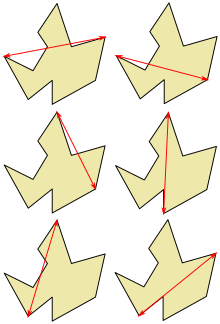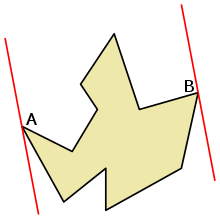Rotating calipers
In computational geometry, the method of rotating calipers is an algorithm design technique that can be used to solve optimization problems including finding the width or diameter of a set of points.

The method is so named because the idea is analogous to rotating a spring-loaded vernier caliper around the outside of a convex polygon.[1] Every time one blade of the caliper lies flat against an edge of the polygon, it forms an antipodal pair with the point or edge touching the opposite blade. The complete "rotation" of the caliper around the polygon detects all antipodal pairs; the set of all pairs, viewed as a graph, forms a thrackle. The method of rotating calipers can be interpreted as the projective dual of a sweep line algorithm in which the sweep is across slopes of lines rather than across x- or y-coordinates of points.
History

The rotating calipers method was first used in the dissertation of Michael Shamos in 1978.[2] Shamos uses this method to generate all antipodal pairs of points on a convex polygon and to compute the diameter of a convex polygon in time. Godfried Toussaint coined the phrase "rotating calipers" and also demonstrated that the method was applicable in solving many other computational geometry problems.[3]

Shamos's algorithm
Shamos gave following algorithm in his dissertation (pp 77–82) for the rotating calipers method that generated all antipodal pairs of vertices on convex polygon:[2]
/* p[] is in standard form, ie, counter clockwise order,
distinct vertices, no collinear vertices.
ANGLE(m,n) is a procedure that returns the clockwise angle
swept out by a ray as it rotates from a position parallel
to the directed segment Pm,Pm+1 to a position parallel to Pn,Pn+1
We assume all indices are reduced to mod N (so that N+1 = 1).
*/
GetAllAntiPodalPairs(p[1..n])
//Find first anti-podal pair by locating vertex opposite P1
i = 1
j = 2
while angle(i, j) < pi
j++
yield i,j
/* Now proceed around the polygon taking account of
possibly parallel edges. Line L passes through
Pi, Pi+1 and M passes through Pj, Pj+1
*/
//Loop on j until all of P has been scanned
current = i
while j != n
if angle(current, i+1) <= angle(current, j+1)
j++
current = j
else
i++
current = i
yield i,j
//Now take care of parallel edges
if angle(current, i+1) = angle(current, j+1)
yield i+1, j
yield i, j+1
yield i+1, j+1
if current = i
j++
else
i++
Another version of this algorithm appeared in the text by Preparata and Shamos in 1985 that avoided calculation of angles:[4]
GetAllAntiPodalPairs(p[1..n])
i0 = n
i = 1
j = i+1
while (Area(i,i+1,j+1) > Area(i,i+1,j))
j = j+1
j0 = j
while (j != i0)
i = i+1
yield i,j
while (Area(i,i+1,j+1) > Area(i,i+1,j)
j=j+1
if ((i,j) != (j0,i0))
yield i,j
else
return
if (Area(j,i+1,j+1) = Area(i,i+1,j))
if ((i,j) != (j0,i0))
yield i,j+1
else
yield i+1,j
Applications
Pirzadeh[5] describes various applications of rotating calipers method.
Distances
- Diameter (maximum width) of a convex polygon[6][7]
- Width (minimum width) of a convex polygon[8]
- Maximum distance between two convex polygons[9][10]
- Minimum distance between two convex polygons[11][12]
- Widest empty (or separating) strip between two convex polygons (a simplified low-dimensional variant of a problem arising in support vector machine based machine learning)
- Grenander distance between two convex polygons[13]
- Optimal strip separation (used in medical imaging and solid modeling)[14]
Bounding boxes
- Minimum area oriented bounding box
- Minimum perimeter oriented bounding box
Triangulations
- Onion triangulations
- Spiral triangulations
- Quadrangulation
- Nice triangulation
- Art gallery problem
- Wedge placement optimization problem[15]
Multi-Polygon operations
Others
See also
- Convex polygon
- Convex hull
- Smallest enclosing box
- es:Rotating calipers
References
- "Rotating Calipers" at Toussaint's home page
- Shamos, Michael (1978). "Computational Geometry" (PDF). Yale University. pp. 76–81.
- Toussaint, Godfried T. (1983). "Solving geometric problems with the rotating calipers". Proc. MELECON '83, Athens. CiteSeerX 10.1.1.155.5671. Cite journal requires
|journal=(help) - Shamos, Franco P. Preparata, Michael Ian (1985). Computational Geometry An Introduction. New York, NY: Springer New York. ISBN 978-1-4612-7010-2.
- Pirzadeh, Hormoz (1999). "Computational geometry with the rotating calipers". McGill Library.
- Binay K. Bhattacharya and Godfried T. Toussaint, "Fast algorithms for computing the diameter of a finite planar set," The Visual Computer, Vol. 3, No. 6, May 1988, pp.379–388.
- Binay K. Bhattacharya and Godfried T. Toussaint, "A counter example to a diameter algorithm for convex polygons," IEEE Transactions on Pattern Analysis and Machine Intelligence, Vol. PAMI-4, No. 3, May 1982, pp. 306–309.
- Michael E. Houle and Godfried T. Toussaint, "Computing the width of a set," IEEE Transactions on Pattern Analysis & Machine Intelligence, Vol. 10, no. 5, September 1988, pp. 761–765.
- Godfried T. Toussaint and Jim A. McAlear, "A simple O(n log n) algorithm for finding the maximum distance between two finite planar sets," Pattern Recognition Letters, Vol. 1, 1982, pp. 21–24.
- Binay K. Bhattacharya and Godfried T. Toussaint, "Efficient algorithms for computing the maximum distance between two finite planar sets," Journal of Algorithms, vol. 14, 1983, pp. 121–136.
- Godfried T. Toussaint and Binay K. Bhattacharya, "Optimal algorithms for computing the minimum distance between two finite planar sets," Pattern Recognition Letters, vol. 2, December, 1983, pp. 79–82.
- "Rotating Calipers". 2015-03-30. Archived from the original on 2015-03-30. Retrieved 2017-03-22.CS1 maint: BOT: original-url status unknown (link)
- MARTINEZ, HUGO M. (January 1, 1978). "Review of: "PATTERN SYNTHESIS", by U. Grenander, Springer-Verlag, New York, 1976. 509 pp". International Journal of General Systems. 4 (2): 126–127. doi:10.1080/03081077808960672. ISSN 0308-1079.
- Barequet and Wolfers (1998). "Optimizing a Strip Separating Two Polygons". Graphical Models and Image Processing. 60 (3): 214–221. doi:10.1006/gmip.1998.0470.
- Teichmann, Marek (1989). "Wedge placement optimization problems". Cite journal requires
|journal=(help) - Godfried T. Toussaint, "A simple linear algorithm for intersecting convex polygons, The Visual Computer, Vol. 1, 1985, pp. 118–123.
- Tomas Lozano-Perez, "Spatial planning: A configuration space approach," IEEE Transactions on Computers, Vol. 32, No. 2, 1983, pp. 108–120.
- Binay K. Bhattacharya and Godfried T. Toussaint, "Computing shortest transversals," Computing, vol. 46, 1991, pp. 93–119.
- Binay K. Bhattacharya, Jurek Czyzowicz, Peter Egyed, Ivan Stojmenovic, Godfried T. Toussaint, and Jorje Urrutia, "Computing shortest transversals of sets," International Journal of Computational Geometry and Applications, Vol. 2, No. 4, December 1992, pp. 417–436.
- Jean-Marc Robert and Godfried T. Toussaint, "Linear approximation of simple objects," Computational Geometry: Theory and Applications, Vol. 4, 1994, pp. 27–52.
- Rasson and Granville (1996). "Geometrical tools in classification". Computational Statistics & Data Analysis. 23 (1): 105–123. doi:10.1016/S0167-9473(96)00024-2.
- Bose, P.; Hurtado-Diaz, F.; Omaña-Pulido, E.; Snoeyink, J.; Toussaint, G. T. (2002-08-01). "Some Aperture-Angle Optimization Problems". Algorithmica. 33 (4): 411–435. CiteSeerX 10.1.1.16.7118. doi:10.1007/s00453-001-0112-9. ISSN 0178-4617.
- "Incorrect Diameter Algorithms for Convex Polygons".